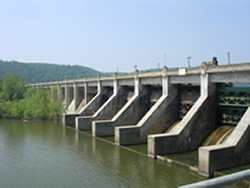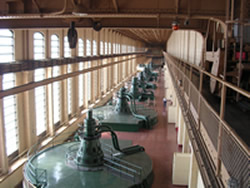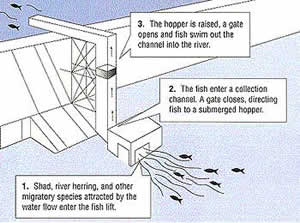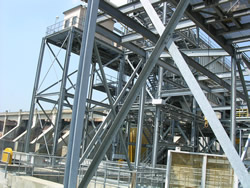A Report from Energy Ant — My Trip to Visit Safe Harbor Station Along the Susquehanna River in Pennsylvania

When you drive up to Safe Harbor Station, one of the hydroelectric dams on the Susquehanna River, it’s hard to tell just how big it really is. When you drive to Pennsylvania, you see many dams on the Susquehanna River. It is kind of hard to tell how big a dam really is just by driving by, so I decided to visit the hydroelectric dam at Safe Harbor Station and see just how big it is and how it works.
Hydroelectric dams like this one are built to block part of a river. A lake forms behind the dam and water from the lake is sent through the dam to the river below. This dam is 75 feet tall and the water drops about 55 of those feet before being used for electricity.
Hydroelectric dams use kinetic energy, or the energy of motion. Moving water (sometimes referred to as "white coal") spins a turbine, which in turn spins the rotor of a generator to produce electricity.

A hydroelectric dam always has at least one generator in it. There are a lot of dams that don’t have generators, but they do not make electricity. Those dams were built for other reasons, like flood control.
At Safe Harbor there are twelve generators. Each generator is connected to a turbine. The turbine is like a huge pinwheel in the water. As the water drops from the top of the dam, it passes by the turbine and turns the blades. The turbine then turns the generator which changes motion energy into electrical energy.
Sounds pretty simple, huh? Well, it is. One of the neat things about a hydroelectric dam is that it is very easy to decide how many of the generators you want to run. If you have a lot of water and a lot of people using electricity, a few clicks on the computer can open up another turbine to increase generation.


However, dams can make life difficult for certain types of fish that migrate. American Shad, like many other fish, travel up the river to reproduce.Every spring, Shad travel up the same river they were born in to lay their eggs. If there is a dam in the way, fish are not able to swim past it. This has caused the American Shad population to fall sharply over the years. To help the fish, Safe Harbor was required to put in a fish lift. The water currents direct the fish into a swimming pool size bucket that is on a big elevator. This bucket is raised up to the top of the dam and the fish are released into a flume. The flume leads out to the water above the dam. A scientist records the number of American Shad that pass through the lift everyday. While it is American Shad that the scientists are looking for, that doesn’t stop other fish and animals from using the lift. The fish have no problem getting back down river. They just go through the turbines. Think of it like a water slide. With the help of fish lifts and other devices at other dams on the river, the Shad population is increasing again.
My trip to Safe Harbor Station was really cool. Watching the "Shad run" was pretty awesome. Just how those fish counters can tell through the cloudy and dirty water which fish are American Shad and which ones aren't, I have no clue; but I do hope I can come back again to see the dam and the Shad!


